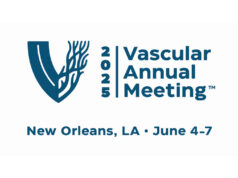
“All vascular surgeons have access to the same randomized trials and guidelines, which should harmonize international treatment patterns, but this is not always the case,” says Maarit Venermo, MD, PhD, University Hospital and University of Helsinki, Finland, giving VS@VAM a sneak peek of her upcoming John Homans Lecture this morning (Thursday, June 20, 9:30–10:00 a.m. in the West Building, Level 3, Skyline Ballroom).
At present, Venermo shares, there is “remarkable” international variation in vascular surgery services which are seen through indications for treatment, patient demographics, sex distribution and treatment profiles.
“For example, the proportion of asymptomatic patients in carotid surgery varies between 0–80%, and the proportion of women from 12–40%. In abdominal aortic aneurysm surgery, the proportion of small aneurysms [<55mm aneurysms] vary from less than 10% to almost 30%.”
The reasons for these geographical differences are many, she says, due to prevalence of vascular diseases, risk factors and life expectancy.
However, in following evidence-based practice, vascular care “should” be harmonized internationally. Yet, as Venermo makes clear, this is not always the case.
“Despite the 10-year results from the Asymptomatic Carotid Surgery Trial 1 [ACST1] showing that patients with a life expectancy less than five years do not benefit from carotid surgery—and younger patients with tight stenosis do—the treatment of asymptomatic stenosis has remained the same in a majority of the countries before and after the publication.”
However, if data have not largely influenced vascular care, Venermo explains, reimbursement has been “a force” for change. “In countries that have a fee-for-service reimbursement system, the proportion of asymptomatic carotid patients and patients with small aneurysms who undergo surgery is higher, compared to countries with a public health system,” she says.
“Ultimately, all of the current evidence has been evaluated carefully in the guidelines, and the recommendations have been built on the basis of evidence.”












